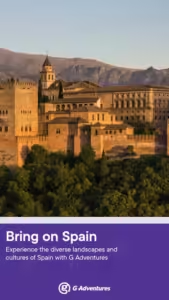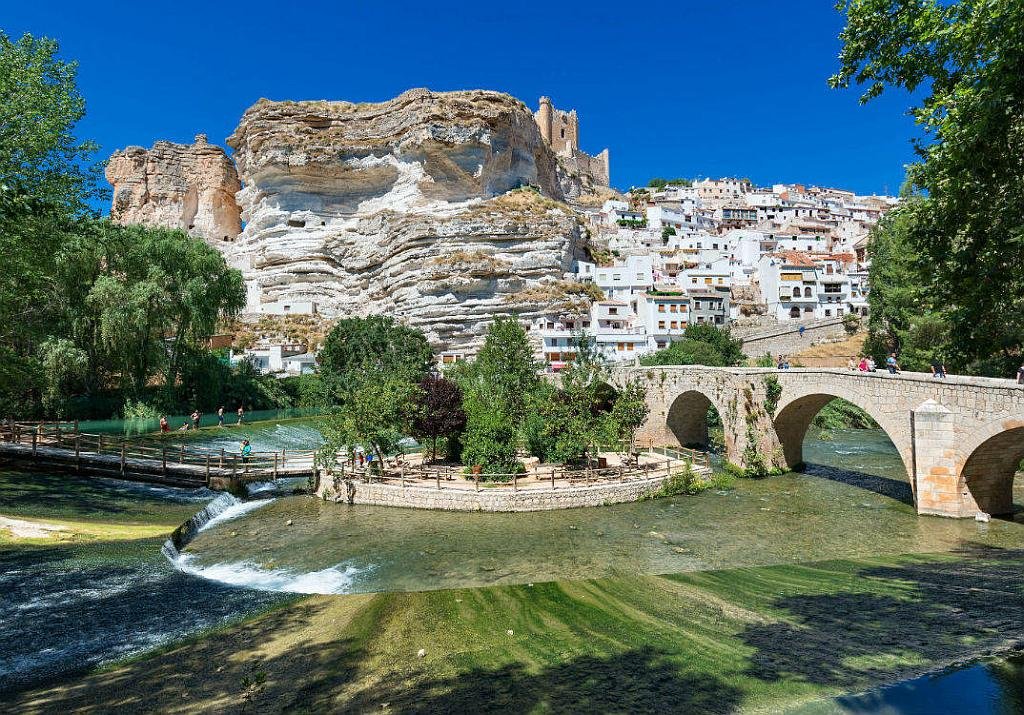Walking and wildlife holidays in Castilla la Mancha
- Capital: Toledo.
- Area: 79,463 km²
- Provinces 5: Guadalajara, Toledo, Cuenca, Ciudad Real, Albacete
Above photo Alcalá del Júcar, in the province of Albacete Photo: Turismo de Castilla-La Mancha

Castilla la Mancha, the birthplace of Miguel de Cervantes who penned the legendary novel ‘Don Quixote de la Mancha,’ is a region steeped in rich cultural history.
This vast region of central Spain is home to the iconic windmills immortalized in Cervantes‘ work and boasts a landscape that is both breathtakingly beautiful and fascinatingly unique.
Find some great hotels, apartments and bed and breakfasts in Castilla la Mancha over at Booking.com
Some great drone footage from Castilla la Mancha

While the world’s largest vineyards, Manchego cheese, sunflowers, and saffron are often talked about when referring to Castilla la Mancha, it is the stunning natural beauty and thriving wildlife that make this region truly special.
From rolling plains and rugged mountain ranges to tranquil rivers and lush forests, Castilla la Mancha offers a diverse range of natural wonders waiting to be explored.
Here are a few highlights of this beautiful region.
- Near Cuenca, is a wooded and mountainous zone where the source of the river Cuervo creates an unusual green oasis.
- The Ciudad Encantada is a fascinating maze of eroded rock formations that really are enchanting.
- Near Ciudad Real are natural lagoons that are linked by waterfalls creating a beautiful landscape.
- There is the outstanding ecological marsh land of Las Tablas de Daimiel, an important stopping-off place for migratory and wintering waterfowl. In addition are the Montes de Toledo. Each of these offering a different landscape and habitat.
Tours in Castilla la Mancha from Viator
Castilla la Mancha has a vast array of sites to visit and enjoy. Below are some of the options listed on the Viator website. (We recieve a small commission if you book a tour which doesn’t cost you more and helps us to keep Wildside Holidays up to date with the best information.)
Natural parks in Castilla la Mancha

Have you visited any on these natural Parks?
Send us some feedback by leaving a comment.
1 The Sierra Norte de Guadalajara Natural Park Incorporated into this area is the The Hayedo de Tejera Negra Natural Park (a beech forest located in Cantalojas in the northwestern corner of the province of Guadalajara and is the most southern forest of its kind in Europe).
2 Barranco del rio dulce Natural Park This spectacular landscape was popularized by the famous naturalist Félix Rodríguez de la Fuente as it provided the ideal setting for a number of his television wildlife documentaries. (Especially those dedicated to eagles)
3 Alto Tajo Natural Park Pine forests and spectacular cliff formations make for a wonderful area to explore with over 40 villages and towns within the parks boundaries. There are several Special Protection Areas for Birds (ZEPA) and Special Conservation Zones (ZEC) established in accordance with the Natura 2000 Network.
4 National Park of Cabañeros Located within the two provinces of Ciudad Real and Toledo. It is the best and largest surviving area of Iberian Mediterranean forest, with an enormous variety of plant species. Botanical heaven!
5 National Park of Tablas de Daimiel Formed at the confluence of the Guadiana River and its tributary the Cigüela this is one of the most important aquatic ecosystems in the Iberian Peninsula and is home to a great variety of fauna and flora especially aquatic birds both resident and migratory.
6 Lagunas de Ruidera Natural Park The Lagunas de Ruidera Natural Park acts as a buffer zone to the Tablas de Daimiel National Park and It consists of a complex lagoon system made up of fifteen lagoons, which over 30 kilometers constitute the Alto Guadiana valley and in its highest part the source of the Guadiana river.
7 Calares del Rio Mundo y Sima The Mundo river is well known for its picturesque source. The river originates from a cave in the middle of a tall cliff and forms a waterfall with a height of almost 100 meters. Subsequently, it forms a series of smaller cascades and pools.
The Serranía de Cuenca Natural Park is located in the northeast of the province of Cuenca and within the mountain range of the same name. (The area known as the Serranía de Cuenca itself is much larger and is within the provinces of Cuenca, Guadalajara and Teruel).
The Iberian highlands rewilding project
If this project is a success it will create an impressive backdrop and opportunity for sustainable wildlife tourism in Spain. Hides for bird photography in steppe environments, Iberian lynx, raptors and other birds of prey along with large mammals will certainly draw the attention of companies that offer this type of wildlife holiday. Hopefully (and perhaps most importantly) many local companies will also be able to take advantage of this extra protection given to this massive and impressive area in Eastern Iberia. Read more here: https://wildsideholidays.co.uk/the-iberian-highlands-rewilding-project/
Find some great hotels, apartments and bed and breakfasts in Castilla la Mancha over at Booking.com
Other places to see
The Ciudada Encantada – I first stumbled across the Ciudad Encantada in Cuenca whilst on a long road trip over 20 years ago and, I remember then being totally awed by the amazing formations on this 3 km stroll through pine forest and rock.
FAQ: Nature and Culture in Castilla-La Mancha
Castilla-La Mancha is the birthplace of Miguel de Cervantes, author of Don Quixote de la Mancha. The region’s famous windmills, referenced in the novel, are now iconic symbols of Spanish heritage. Its towns and landscapes echo a rich literary and historical legacy that continues to attract cultural tourism.
While known for Manchego cheese, saffron, and vast vineyards, Castilla-La Mancha also offers dramatic natural attractions. Explore the green oasis at the source of the River Cuervo near Cuenca, the surreal rock formations of Ciudad Encantada, and the waterfall-linked lagoons near Ciudad Real. The wetlands of Las Tablas de Daimiel and the Montes de Toledo also stand out for their ecological value and biodiversity.
The region is home to several key protected areas:
Sierra Norte de Guadalajara: Includes Tejera Negra, Europe’s southernmost beech forest.
Barranco del Río Dulce: Filming site of wildlife documentaries by Félix Rodríguez de la Fuente.
Alto Tajo: Known for pine forests, dramatic cliffs, and protected bird habitats.
Cabañeros National Park: Spain’s best-preserved Iberian Mediterranean forest.
Tablas de Daimiel National Park: A vital wetland for resident and migratory birds.
Lagunas de Ruidera: A chain of fifteen interconnected lagoons, forming part of the Guadiana River’s origin.
Calares del Río Mundo y Sima: Features a spectacular 100-meter waterfall from a cliffside cave.
Serranía de Cuenca: A rugged mountainous zone filled with trails, cliffs, and forest.
This initiative aims to rewild a vast section of Eastern Iberia, promoting sustainable wildlife tourism. The project focuses on restoring habitats for Iberian lynx, raptors, and large mammals. It also supports the development of wildlife hides and nature-based experiences, helping local communities benefit from eco-tourism while increasing protection for the region’s ecosystems.
About the author of this article.
I’ve been living in this lovely area of Western Andalucia for the last 20 years or so and dedicate most of my time to the running of English language tourist information websites for the towns of Cádiz, Ronda, Grazalema, the famous or infamous Caminito del Rey, and also Wildside Holidays, which promotes sustainable and eco-friendly businesses running wildlife and walking holidays in Spain.
Please feel free to leave a comment on any and all of our information pages for Natural and National Parks in Spain.

